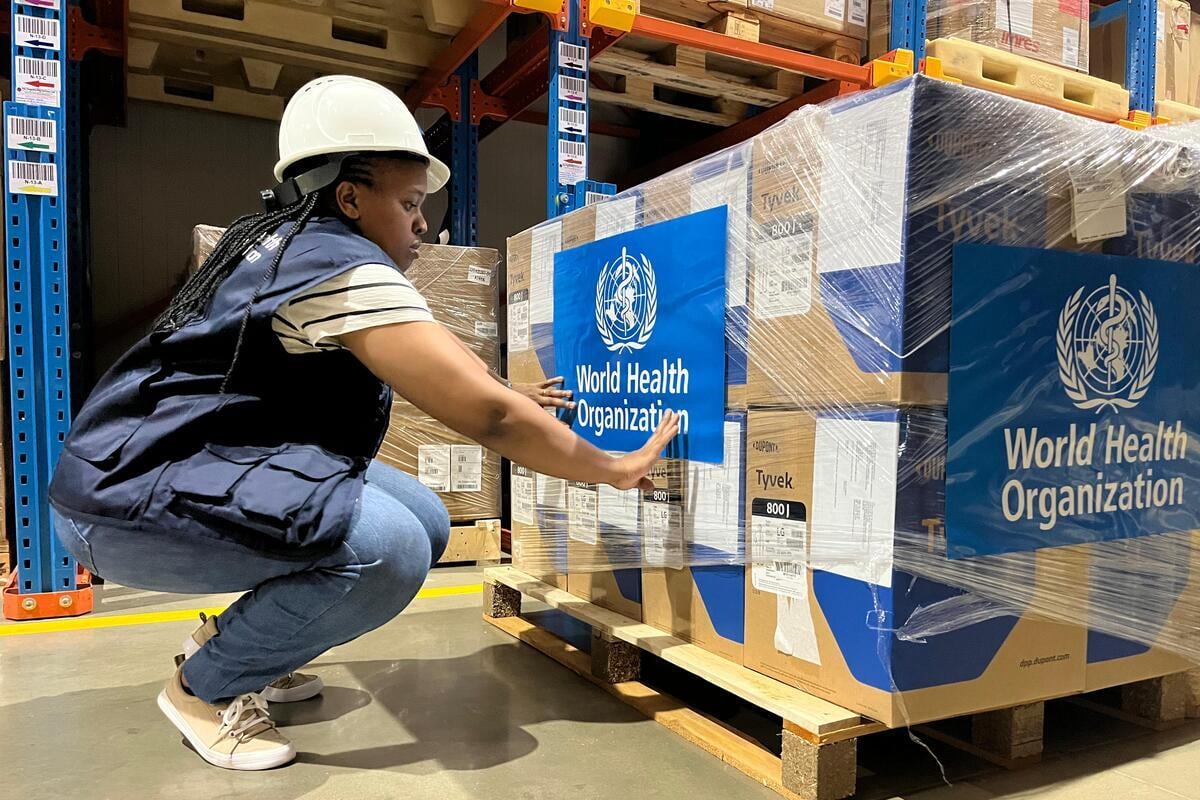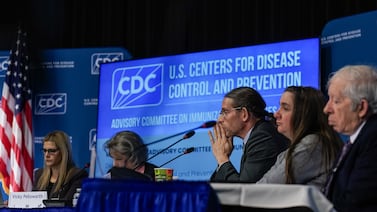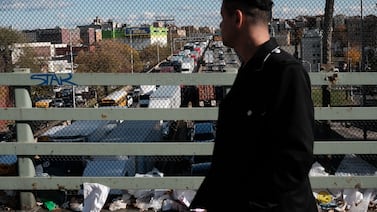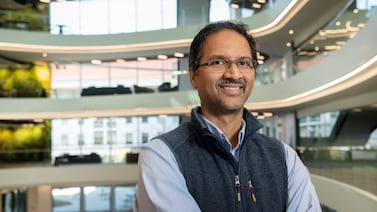Public health, explained: Sign up to receive Healthbeat’s Global Checkup in your inbox a day early.
Hello from Nairobi.
The sun is shining, and the jacarandas are shedding a purple rain of flowers all along my street. This week, I’m thrilled to share the news that the Global Health Checkup will now be available a day early, every Wednesday, to email subscribers.
You can sign up here.
My name is William Herkewitz, and I’m a journalist based in Nairobi, Kenya. This is the Global Health Checkup, where I highlight five of the week’s most important stories on outbreaks, medicine, science, and survival from around the world.
With that, as we say in Swahili: karibu katika habari — welcome to the news.
Ebola update: signs of containment
We’ve been following the worrying Ebola outbreak in the Democratic Republic of the Congo. Our focus has been on how the World Health Organization, alongside partners like the Red Cross and Doctors Without Borders, have scrambled to contain the disease amid severe funding shortfalls. I want to know: Does the world still have the muscle to manage major health emergencies now that the U.S. Agency for International Development (defunct) and the U.S. Centers for Disease Control and Prevention (hobbled) are no longer footing most of the bill, as was true for past epidemics?
In my last update on Oct. 2, I noted that the WHO was sounding some fairly dire alarms: International donors had pledged less than a fourth of what was needed, and the outbreak had already “overwhelmed” health facilities at the epicenter of the crisis. Worrying signs, all.
So it’s a welcome bit of whiplash that the WHO now reports a “potential control of transmission,” which means that 10 days have passed without any newly reported Ebola cases, the Associated Press reports.
I’ll admit, after my last update I found this news surprising, and a good reason to check my priors! Could this be a sign that the American pullback is less crippling to global health than many feared? To get perspective, I reached out again to Dr. Paul Spiegel, director of the Johns Hopkins Center for Humanitarian Health.
To start, Spiegel called the WHO’s report “encouraging,” although “it’s important to interpret it cautiously,” he said. “Ebola’s incubation period can extend up to 21 days, so a 10-day period without new cases suggests progress, but not definitive containment.”
(I also reached out to the Red Cross, and Fatou Mwaluke, a health coordinator in Kinshasa, tempered any rush to celebrate: “Surveillance teams are actively monitoring nearly 2,000 contacts, and several suspected cases remain under laboratory investigation,” she said, reminding me to avoid the temptation of conflating “delays in reporting and testing” with concrete success.)
Still, Spiegel says the progress “likely reflects effective surveillance, isolation, and community engagement,” all of which are vital but expensive to sustain in such a remote region. To me, this sounds like tentative proof that the WHO and partners like the Red Cross managed to rally new resources after sounding the alarm. And more importantly, that there may be still enough committed actors out there willing to step up, at least for this outbreak.
As for the broader takeaway for global health? Spiegel sees this moment as both promising and precarious. It may indicate “growing resilience” and “diversified global health partnerships,” in a post-American largesse world, but he noted “a structural vulnerability” in how the world pays for emergencies like this. After all, how secure can the system be if it depends on reactive, one-off appeals that pull resources from other crises rather than building lasting capacity?
In short: a promising pause, but not yet victory.
The early-bird flu
Time magazine reports that influenza is breaking tradition, spreading earlier than its usual season across Asia. (Worldwide, the flu is largely seasonal because the virus spreads more easily in cool, dry air, and when people spend more time indoors and close together.)
In Japan, officials declared a nationwide flu epidemic after cases skyrocketed five weeks earlier than usual. Schools and child care centers closed, and 60% of Japanese prefectures saw rising flu counts. “But it’s not just Japan. Flu cases have risen in recent weeks in other countries across the continent, including Singapore, Thailand, and India.”
It’s a long article, but the takeaway comes right at the top: The “surge of influenza cases … has led some medical experts to warn that getting sick more easily throughout the year may be the new reality.”
What’s driving the shift? Experts point to two converging pressures, with plenty of nerdy disagreement on which is the main cause. The first pressure is genetic: the slow evolutionary drift in flu viruses that help them adapt and circulate when there’s a new opportunity. Basically, the virus is evolving. The second pressure is climate change, where shifts in rainfall, increased indoor crowding during extreme weather, and changing seasonal habits in tropical regions may all be eroding the old boundaries of “flu season.”
I know what you’re thinking: If only there were a simple, once-a-year shot that could help prevent all this … oh wait.
Rift Valley Fever outbreak in Senegal
Senegal has confirmed over 100 cases and 17 deaths from an outbreak of Rift Valley Fever, in what officials are calling the “country’s worst in decades,” Africa News reports.
Disease breakdown: Rift Valley Fever is a centuries-old virus, best understood as a livestock disease that occasionally spills over into humans. It primarily affects herding animals, including cattle, goats, sheep, and camels. It spreads through mosquitos (or, occasionally, animal slaughter) and is largely isolated to Africa, the Arabian Peninsula, and some islands in the Indian Ocean. While the majority of cases in humans present as symptomless or as a flu-like fever, it can occasionally lead to coma, loss of vision, or fatal hemorrhaging.
What’s behind the outbreak? Officials are blaming “climate change … for creating ideal breeding conditions for mosquitoes,” with unusually heavy downpours in Northern Senegal followed by intense heat.
At first glance, this might sound like a fairly local story. But there’s more at stake here than meets the eye. The disease is a test for regional cooperation, as it threatens a rough triangle between northern Senegal, Mauritania, and Mali. For context, this is a dramatically underdeveloped region where herders, livestock, and trade routes constantly cross borders. (Underdeveloped may even be an understatement … Mauritania has been described to me as Earth’s own Tatooine.)
It’s an epidemic that’s worth watching closely. There’s an effective vaccine for livestock, but paying for it and deploying it across remote, nomadic, and resource-limited regions is another matter entirely. Like the Ebola story, this one could become a test of how well these national and regional health systems can respond during the global health funding crunch.
Thankfully, there is a bit of luck at play here. Over the weekend, Senegalese scientists confirmed that the current virus is nearly genetically identical to previous outbreaks, so the existing vaccines should work.
An uneven rise in life expectancy
It was a big weekend for the spreadsheet crowd. The Global Burden of Disease report came out, which is the most important recurring study in global health. It is basically the master dataset on what’s killing, sickening, and disabling people around the world, and why. (I imagine that epidemiologists view it publishing like the Coachella lineup dropping.)
The study is a mammoth effort, based on a network of over 16,500 scientists and more than 300,000 data sources. And this year’s edition offers the first true snapshot of health in a fully post-pandemic world. Some of the starkest findings come from the Americas.
According to El País, while global life expectancy has rebounded to record highs (76 years for women and 71 for men) across North and South America, deaths among people in their 20s and 30s have risen much more sharply. These deaths are largely driven by suicide, drug use, and alcoholism, which the researchers call “muertes por desesperación,” or “deaths of despair.”
The biggest increases were observed in the United States, Canada, Mexico, and Brazil, where deaths in the 25-to-29 age group have risen almost 32%, and 50% among people in their 30s (!).
What’s the takeaway? A little humility, to start. There are clearly political and social forces behind these numbers, but I’m internalizing this as a reminder: Progress in public health doesn’t move in a straight line. Even in the world’s wealthiest countries, as science pushes life expectancy higher, and infectious diseases retreat, social fractures and mental health crises are cutting lives short.
From health policy to ideology police
For decades, U.S. global health funding has come with political strings attached. The best known is officially called the “Mexico City Policy.” Under Republican presidents, it bars foreign NGOs that receive U.S. funding from offering, promoting, or even mentioning abortion services … even if they use their own money to do so. (Within USAID, we use to call it the “global gag rule.”)
In practice, it has historically forced clinics in dozens of countries to choose between keeping U.S. financial support or providing comprehensive reproductive health care. The rule is a kind of foreign-policy pendulum I watched swing back and forth during my time at USAID, rescinded under Democratic presidents and reinstated under Republicans, disrupting programs every few years.
Now, the Trump administration is reportedly pushing to extend this model beyond abortion, The Guardian reports. According to Politico, countries, UN agencies, and NGOs are being told to drop all diversity, equity, and inclusion programs or risk losing all funding. If implemented, it would mark the first time the United States has used its global health purse not just to restrict services, but to police ideology itself.
The takeaway? The potential consequences are enormous. As one source told The Guardian: “It risks causing real human suffering, undermining global health, and destabilizing decades of partnerships and progress.”
I’ll see you all next week!
William Herkewitz is a reporter covering global public health for Healthbeat. He is based in Nairobi. Contact William at wherkewitz@healthbeat.org.






